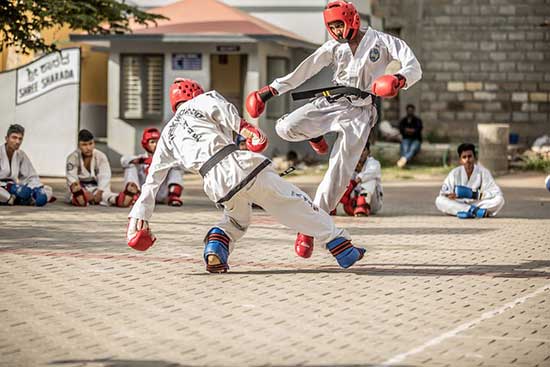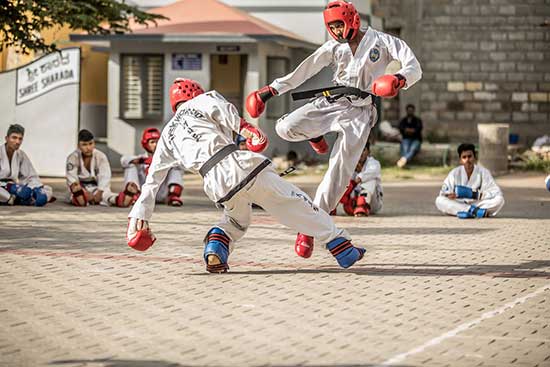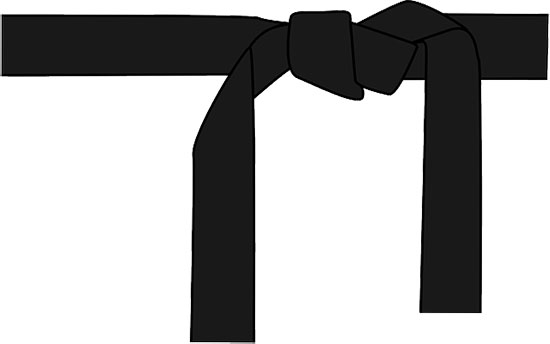In Taekwondo WTF (World Taekwondo Federation), belts are divided into two large degrees: student belts (gup or kup) that are white to brown in color and master belts (dan) that black in color. Also in Taekwondo WTF, there is a separate degree – pum, denoting the teenage, or children’s black belt in Taekwondo.
The WTF system consists of six colored belts; white, yellow, green, blue, red and black.
WTF Taekwondo belt system:
- 10 kup – white belt
- 9 kup – white belt with a yellow stripe
- 8 kup- a yellow belt.
- 7 kup – a yellow belt with a green stripe.
- 6 kup – green belt.
- 5 kup – green belt with a blue stripe.
- 4 kup – blue belt.
- 3 kup – the blue belt with a red stripe.
- 2 kup- the red belt.
- 1 kup – the red belt with a black stripe.
- 1 pum – the red-black belt on the whole length of the teenage children’s black belt (up to 18 years).
- 1 Dan – black belt with one gold pin
- 2 Dan – black belt with two gold stripes and so on up to 9th Dan.

Dan degrees
- 1-3 Dan – Assistant Instructor
- 4-6 Dan – International instructor
- 7-8 Dan – Master Instructor
- 9 Dan – Grandmaster. 9th dan is honorary, it is awarded for merits in the promotion of taekwondo
Contents
How many belts are there in Taekwondo WTF?
In total there are in 7 belts. Below we will talk about each one and their meaning.
White belt
Means the beginning. The taekwondo fighter is just beginning his journey.
Yellow belt
These are only the initial stages in a long journey that the young warrior will overcome for many years. He has already begun to move but has achieved practically nothing.
Green belt
At this stage, the teacher notices that the sown seeds have already sprouted in his ward, but so far they are weak. He already understands and takes more seriously the discipline in which he acts, but he still has a lot to learn.
Blue belt
Characterizes the sky and the depths of the sea. The fighter gradually realizes how wide and deep martial arts he is engaged in. He reaches heights, but at the same time, he is just beginning to learn the philosophy of Taekwondo.
Red belt
This is the time when the fruits are ripe and the harvest is harvested. The results are summed up, and knowledge reaches maturity. The belt wearer looks back at his past, realizes that he managed to get through, but he also does not stop, because he still has a lot to learn.
Brown belt
A powerful combination of a strong technical base and spiritual qualities. It is a tree firmly rooted in the soil. It will be able to withstand any bad weather and adverse conditions.
Black belt
Wisdom, the pinnacle of everything. The peculiarity of this color lies in the unification of all palettes. Its owner got to the very top and grasped all aspects of the discipline. He learned taekwondo.
What do you need to know in order to get each belt?
White belt with yellow stripe
- You should know the apsogi-jumbi stance.
- Know the kicks: ap chagi and lobe of chaga (in the stomach and in the head).
- To be able to do tap and tap strikes.
- Push-ups – 8 times
- Splits (longitudinal)
Yellow belt
- Know the apsogi-jumbi stance.
- Know the kicks: lobe of chaga (in the stomach and in the head) and neri chaga.
- Push-ups – 10 times
- Twine – all 3
Yellow belt with a green stripe
- Know the apsogi-jumbi stance.
- Know the kicks: lobe of chaga (in the stomach and in the head), neri chaga, the world of chaga, dvit chagi
- Push-ups – 15 times
- Split – all 3
Green Belt
- Know the apsogi-jumbi stance.
- Know the kicks from the yellow belt plus tondole chaga.
- Series of blows: neri chaga + lobe of chaga, share of chaga + dvit chaga, tondole chagi + dvit chagi.
- Push-ups – 20 times
Green belt with a blue stripe
Know the apsogi-jumbi stance.
Know the kicks from the green belt plus furry chaga.
Strikes on the paws from the step (from the back, from the front leg):
– lobe of chaga (in the stomach and in the head);
– neri chaga;
– the world of chaga;
– dvit chagi (in attack and counterattack);
– furu chagi (in attack and counterattack).
Series of blows (in attack and counterattack):
– neri chaga + lobe of chaga;
– share of chaga + dvit chaga;
– share of chaga + chaga fury.
Push-ups – 25 times
Split – all 3
Blue belt
Know the apsogi-jumbi stance.
Know the kicks from the green belt with stripe plus tondole chaga.
Strikes on the paws from the step (from the back, from the front leg):
– lobe of chaga (in the stomach and in the head);
– neri chaga;
– the world of chaga;
– dvit chagi (in attack and counterattack);
– furry chaga (in attack and counterattack);
– tondole chaga (in the body and head).
Series of blows (in attack and counterattack):
– neri chaga + lobe of chaga;
– share of chaga + dvit chaga;
– share of chaga + chaga fury;
– share of chaga + todole chaga;
– share of chaga + tondole chaga + dvit chagi (furu chagi).
2 sparings of 1.5 minutes in full gear (with mouthguard).
Push-ups – 40 times
There are 2 systems for passing on belts in taekwondo, the Korean system according to which the and the European system of passing on belts. The requirements for passing on belts in both systems are the same.






